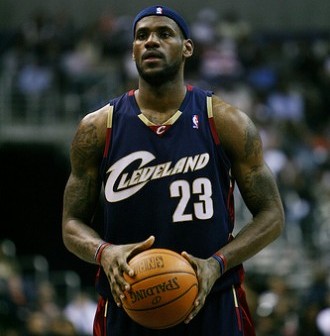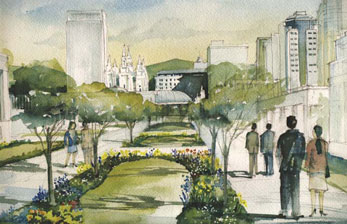 An artist’s rendering of City Creek CenterPhoto courtesy of City CreekSalt Lake City is the world headquarters for the fastest growing church in America, and the influence of the Church of Jesus Christ of Latter-day Saints is everywhere. The six gray spires of the Salt Lake Temple rise above the city. A gleaming granite convention center dominates an entire city block across the street. Even in subtle ways — street names, for example — one is reminded of the church’s impact on city planning. Are you driving down 400 South? Then you’re four blocks south of the temple.
An artist’s rendering of City Creek CenterPhoto courtesy of City CreekSalt Lake City is the world headquarters for the fastest growing church in America, and the influence of the Church of Jesus Christ of Latter-day Saints is everywhere. The six gray spires of the Salt Lake Temple rise above the city. A gleaming granite convention center dominates an entire city block across the street. Even in subtle ways — street names, for example — one is reminded of the church’s impact on city planning. Are you driving down 400 South? Then you’re four blocks south of the temple.
But now the Mormons are poised to have an even greater impact on Salt Lake’s urban design — building a new Vatican City, some say. The $2 billion, 20-acre City Creek Center development, scheduled to be complete in 2012, will mix retail outlets and office space with luxury condominiums boasting views of the temple. Those with the means to purchase the condominiums will likely be members of the church, lured back into the heart of downtown and away from suburban sprawl.
Critics have been wary of the church dominating downtown development, but here’s the surprise: Though not perfectly, developers are following the model set by sustainability meccas like Portland, combining retail, business, and residential space in a way that encourages walking and use of public transit. As the steel beams of the condos take shape — all while providing jobs and hope of better things on the horizon — critics are changing their tune. Maybe a Vatican City is the way to go.
The beginning
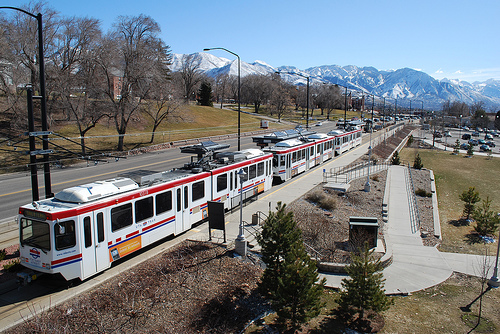 Salt Lake City’s TRAX, seen here near the University of Utah, carries thousands of riders a day.Photo courtesy of Edgar Zuniga via FlickrTwo giant indoor malls in Salt Lake City — the ZCMI Center and Crossroads Plaza, both just a block away from Temple Square — faltered in the 1990s and were nearing foreclosure. In 2001, the year before the Olympics were held in Salt Lake, a new, open-air mixed-use development called the Gateway was born a few blocks west of these failing malls at the site of a renovated historic train depot. Also by this time, TRAX, the light rail system begun in 1999, had proven itself wildly successful at getting people out of their cars and into the city.
Salt Lake City’s TRAX, seen here near the University of Utah, carries thousands of riders a day.Photo courtesy of Edgar Zuniga via FlickrTwo giant indoor malls in Salt Lake City — the ZCMI Center and Crossroads Plaza, both just a block away from Temple Square — faltered in the 1990s and were nearing foreclosure. In 2001, the year before the Olympics were held in Salt Lake, a new, open-air mixed-use development called the Gateway was born a few blocks west of these failing malls at the site of a renovated historic train depot. Also by this time, TRAX, the light rail system begun in 1999, had proven itself wildly successful at getting people out of their cars and into the city.
Watching the success of Gateway, and prodded by city officials to follow a similarly eco-friendly model, the church made plans to raze the two old malls and build its own mixed-use project. (The Mormons already owned the ZCMI Center, and purchased Crossroads in 2003.) The City Creek Center development is a joint effort between Zion Securities — the for-profit arm of the church — and Taubman Centers, Inc., the national mall development company.
The dreamers
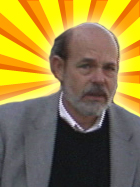 The urban revival of Salt Lake City began in the late 1980s and was led by the city’s artistic community. Artist and urban planner Stephen Goldsmith built Artspace — live/work units for artists in a former warehouse — in the early 1980s, and his project became emblematic of the grass-roots rehabilitation of drug-infested buildings on Salt Lake City’s west side. Many years later, as planning director of the city, Goldsmith championed the idea of mixed-use development in meetings with Mormon leaders. “It’s regretful that the church chose to partner with a national mall developer instead of a local developer,” he says. “There are several design details that I disagree with, but to see a huge mixed-use development in the heart of downtown that is very similar to our original plans — is huge.” (Read a Q&A with Goldsmith about early meetings with Mormon leaders.)
The urban revival of Salt Lake City began in the late 1980s and was led by the city’s artistic community. Artist and urban planner Stephen Goldsmith built Artspace — live/work units for artists in a former warehouse — in the early 1980s, and his project became emblematic of the grass-roots rehabilitation of drug-infested buildings on Salt Lake City’s west side. Many years later, as planning director of the city, Goldsmith championed the idea of mixed-use development in meetings with Mormon leaders. “It’s regretful that the church chose to partner with a national mall developer instead of a local developer,” he says. “There are several design details that I disagree with, but to see a huge mixed-use development in the heart of downtown that is very similar to our original plans — is huge.” (Read a Q&A with Goldsmith about early meetings with Mormon leaders.)
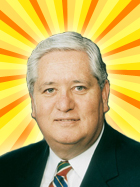 Zion Securities business manager Bishop David Burton is overseeing the City Creek development. Alarmed by the prospect of urban blight just steps away from Temple Square, Burton launched the major redevelopment plan as a way to protect the church’s presence downtown. “Some of the most sacred ground for the church … is immediately adjacent to this project and part of the reason we are proceeding with it,” Burton told a local newspaper in 2007. Forbes magazine dubbed the project “Salt Lake City’s sacred space.”
Zion Securities business manager Bishop David Burton is overseeing the City Creek development. Alarmed by the prospect of urban blight just steps away from Temple Square, Burton launched the major redevelopment plan as a way to protect the church’s presence downtown. “Some of the most sacred ground for the church … is immediately adjacent to this project and part of the reason we are proceeding with it,” Burton told a local newspaper in 2007. Forbes magazine dubbed the project “Salt Lake City’s sacred space.”
 Rocky Anderson, the former mayor of Salt Lake City, worked with Goldsmith to encourage open-air, pedestrian-friendly development downtown and vehemently opposed the “failed paradigm” of enclosed malls. Anderson, a community activist and attorney, won many fans in the green community during his time as mayor from 2000 to 2008. He required energy-efficient light bulbs in all city buildings, replaced SUVs in the city fleet with hybrids, and doubled the city’s recycling capacity.
Rocky Anderson, the former mayor of Salt Lake City, worked with Goldsmith to encourage open-air, pedestrian-friendly development downtown and vehemently opposed the “failed paradigm” of enclosed malls. Anderson, a community activist and attorney, won many fans in the green community during his time as mayor from 2000 to 2008. He required energy-efficient light bulbs in all city buildings, replaced SUVs in the city fleet with hybrids, and doubled the city’s recycling capacity.
The money
The cost of City Creek Center has been kept under a tight lid. All of Zion Securities’ holdings are all kept private but it’s clear that the project has no risk of foreclosure or bankruptcy. The church didn’t require any loans to build City Creek. The church will not comment on the overall costs, nor the rumored overruns. Initially estimates were set at $1.5 billion, but many say the project has far exceeded budget, and now may be nearing $3 billion.
Sales on the $500,000 to $2.5 million condos have exceeded expectations and with the church’s ability to easily market their property to their members, it’s likely the project will prove a financial success.
The outcome
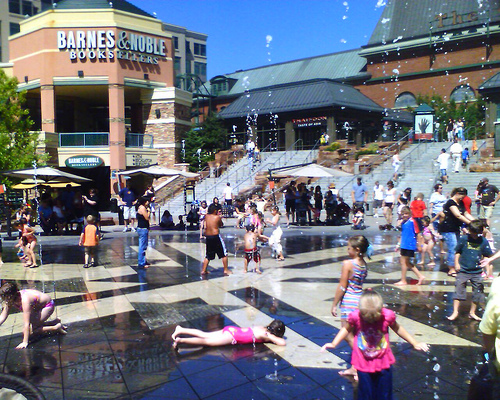 Children play in the Olympic Legacy Fountain at GatewayPhoto courtesy of digitalthom via FlickrThe future of City Creek remains to be seen, but so far Salt Lake City residents have embraced mixed-use, transit-oriented development. TRAX serves downtown, the University of Utah area, and the suburb of Sandy, and carries an average of 43,400 people per day. (That’s nearly double what planners had projected for 2010 when the system was first built.) The Gateway District, lauded by the EPA for its successful revitalization [PDF] of an abandoned historic area, is home to 130 stores and restaurants, 500 residential units, and major employers like the Salt Lake Tribune and Fidelity Investments. Its open space is already well-knit into the community fabric — its Olympic Legacy fountain, for example, is the site for the finish line of the Salt Lake City marathon.
Children play in the Olympic Legacy Fountain at GatewayPhoto courtesy of digitalthom via FlickrThe future of City Creek remains to be seen, but so far Salt Lake City residents have embraced mixed-use, transit-oriented development. TRAX serves downtown, the University of Utah area, and the suburb of Sandy, and carries an average of 43,400 people per day. (That’s nearly double what planners had projected for 2010 when the system was first built.) The Gateway District, lauded by the EPA for its successful revitalization [PDF] of an abandoned historic area, is home to 130 stores and restaurants, 500 residential units, and major employers like the Salt Lake Tribune and Fidelity Investments. Its open space is already well-knit into the community fabric — its Olympic Legacy fountain, for example, is the site for the finish line of the Salt Lake City marathon.
When complete in 2012, City Creek promises 900,000 square feet of retail space, six acres of public space (with a man-made creek running through), five residential towers with 600 condominiums, 1.6 million square feet of office space, and a gourmet grocery store.
The copycats
Not many cities have power players quite like the Mormon church, and that makes Salt Lake City’s urban revival unique. But just as this cosmopolitan city in the heart of the reddest of states demolishes its indoor malls in order to embrace the “live, work, play” mantra of mixed-used development, others are sure to follow.
In Oregon, Portland’s best known art district is another area of mixed use redevelopment. The Pearl District was once an area of warehouses and industrial rail yards. It is now known for its art galleries, upscale businesses, and residences. Having undergone changes since the 1990’s, it now features high-rise condos and loft conversions, all served by a popular streetcar line.
Dallas’s Mockingbird Station is another mix of retail, office, and residential development. Originally built in the 1940’s, the Western Electric Company warehouse, which made the first rotary dial phone, was saved from the wrecking ball and reborn as a mixed use development. The developer reused many of the warehouse’s original materials and elements and created a circular corridor with 180 residential loft units.
